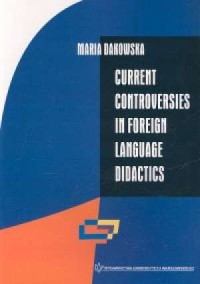
| Dane szczegółowe: | |
| Wydawca: | Wydawnictwa Uniwersytetu Warszawskiego |
| Rok wyd.: | 2003 |
| Oprawa: | miękka |
| Ilość stron: | 182 s. |
| Wymiar: | 170x240 mm |
| EAN: | 9788323500520 |
| ISBN: | 83-235-0052-5 |
| Data: | 2001-02-02 |
Opis książki:
W książce są omówione podstawowe zagadnienia teorii dydaktyki języków obcych, m.in.: pojęcie komunikacji językowej wraz z jej uwarunkowaniami mentalnymi jako procesami, znaczenie poprawności językowej, status błędu popełnianego przez uczących się języka, jego przyczyny i interpretacje, problem nauczania gramatyki języka obcego oraz rozwoju wiedzy metajęzykowej.
Autorka wykazuje celowość rozwijania naukowej dydaktyki językowej, co w konsekwencji prowadzi do usprawnienia procesu nauczania języków obcych.
Książka może służyć naukowcom— glottodydaktykom, a także— jako podręcznik— nauczycielom języków obcych i studentom.
Książka "Current Controversies in Foreign Language Didactics" - Maria Dakowska - oprawa miękka - Wydawnictwo Wydawnictwa Uniwersytetu Warszawskiego. Książka posiada 182 stron i została wydana w 2003 r.
Spis treści:
Chapter One: In search of identity. Language teaching encounters science
1. Introduction
1.1. First things first
1.2. Science, practice and the challenge of applications
1.2.1. How does a science become applicable?
1.3. The advantages and inevitability of the science program
1.4. On cognitive autonomy
1.4.1. A lasting influence of linguistic structuralism on modeling language learning
1.5. Deriving models from the real world
1.5.1. Feasibility of a stability of focus
1.5.2. The significance of time and space
1.5.3. How does an empirical science take roots?
1.5.4. Characteristics of the human being
1.5.5. Human contribution to the dynamics of the process
1.6. Concluding remarks
Chapter Two: Second/foreign language use and learning as a cognitive phenomenon
2. Introduction: The promise and limitations of the cognitive paradigm
2.1. Some cognitive conceptions and their problems
2.1.1. O`Malley and Chamot (1990)
2.1.2. McLaughlin (1987)
2.1.3. Johnson (1996
2.1.4. Ellis (1994)
2.1.5. Skehan (1998)
2.1.6. Robinson (ed., 2001)
2.2. Cognition, cognitivism, a cognitive framework in psychology and psycholinguistics, cognitive foundations of foreign language didactics
2.2.1. Cognition
2.2.2. Cognitivism versus structuralism
2.2.3. A `cardinal` cognitive paradigm in the study of human cognitive functioning
2.2.4. Cognitive foundations of foreign language didactics
2.3. On the specificity of language in the human information processing system
2.4. Synchronic and diachronic perspective of language use and learning
2.5. Language as a specialization of human cognitive ability
2.5.1. Specialization versus modularity
2.6. Language, language use, verbal communication
2.7. Distinctive characteristics of language in cognitive modeling
2.8. Concluding remarks
Chapter Three: Yerbal communication as a social phenomenon
3. Introduction
3.1. Information, signal, sign, and symbol
3.2. Characteristics of verbal communication
3.2.1. Components of the act
3.2.2. Constructing the communicative intention .
3.2.3. Targeting the message at the addressee
3.2.4. Transforming the communicative intention into a verbal message
3.2.5. Reconstructing the communicative intention by the addressee
3.2.6. The status of meaning in verbal communication
3.3. The cyclical nature of verbal communication
3.4. Implications for foreign language didactics
3.5. Yerbal communication versus communicative competence
3.6. Yerbal communication (VC), communicative competence (CC) and their significance for foreign language teaching
3.6.1. The nature of verbal communication
3.6.2. The nature of language
3.6.3. The notion of learning
3.7. Concluding remarks
Chapter Four: Language form and the language leamer
4. Introduction: Two perspectives of language
4.1. First language acquisition and the development of metalinguistic knowledge(MLK)
4.2. Some terminological distinctions
4.3. Constraints on receiving and using metalingual knowledge by foreign language learners
4.4. Some empirical evidence for the use ofrule
4.5. Some conceptions in Second Language Acąuisition Research 4.5.1. Krashen`s Monitor
4.5.2. Bialystok`s conception
4.5.3. Consciousness-Raising
4.5.4. Focus on Form
4.6. Syntax in a model of speech production
4.7. Concluding rernarks
Chapter Five: On the status of error in foreign language didactics , 5.
Introduction
5.1. The learner, the form and the norm
5.2. Synchrony and diachrony of learning a foreign language 5.3. The nature of language learning
5.4. The status of error
5.5. Implications for foreign language teaching
5.6. Concluding remarks
Chapter Six: What is foreign language teaching?
6. Introduction: The fundamental ties between cognition, communication and foreign language didactics
6.1. The problem ofteaching
6.2. Who is the addressee?
6.3. What is organic cultivation?
6.4. The range of techniąues of teaching
6.5. Concluding remarks
Conclusions
References

